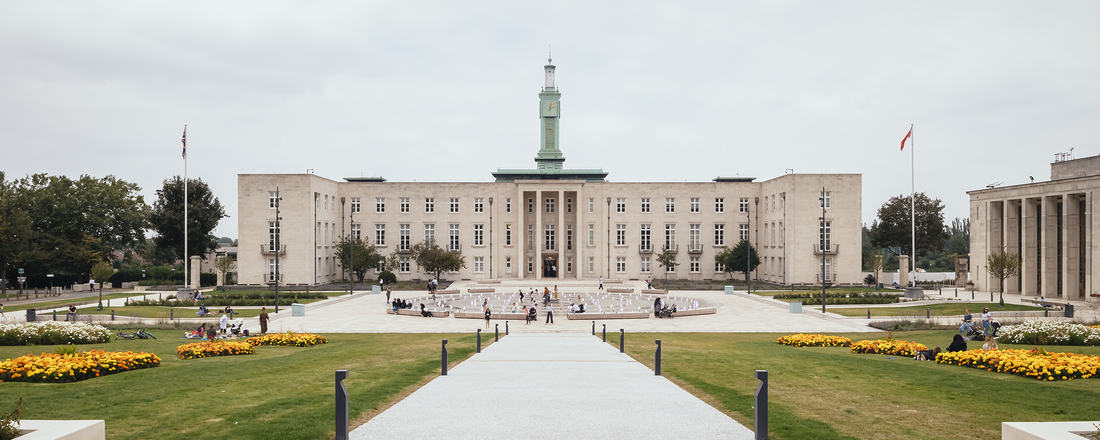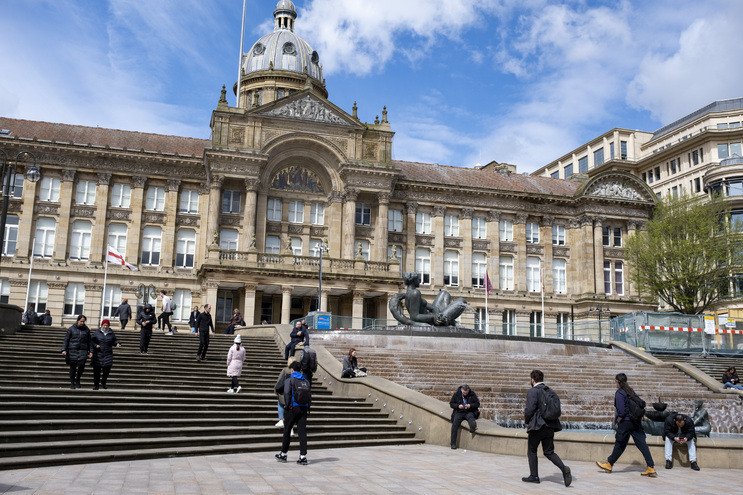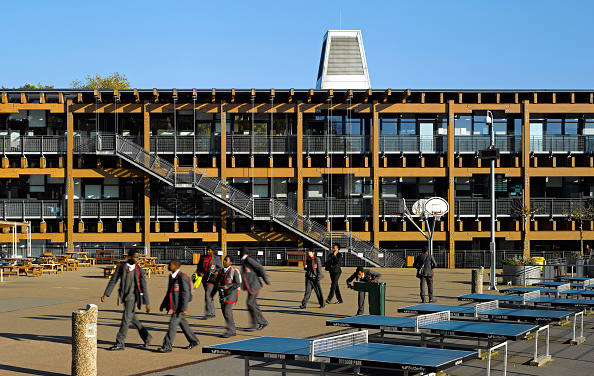Get updates from The Developer straight to your inbox Yes, please!
We must reclaim a sense of pride in our public infrastructure
The good design of civic architecture is the glue that holds our identity together, writes Sarah Wigglesworth MBE

Sarah Wigglesworth MBE founded her own practice based in London in 1993, pioneering an approach to building using low-energy principles ...more
I n an era increasingly dominated by the virtual, many of our public services are now accessible online. I have no doubt that, for most of us, this is a huge convenience. But the availability of online services has rendered their performance a private transaction and, what’s more, only “verifiable” as genuine through the algorithms of the program. Online, the representation of community and civic pride is reduced to the quality of the interface and a logo, but it can never be a substitute for the solid, material sense of belonging that is embodied in our relationship with built fabric and landscapes.
When politicians are fearful of physical contact with the public, we are denied the potential to witness political and civic life in action. To my mind, this raises a concern for how we engage with democracy and the representation of our values as reflected in our public institutions. In fact, it asks what the role of buildings as manifestations of civic order have to play in our increasingly atomised, intolerant society.
Once upon a time, wealthy individuals and organisations secured their legacy by constructing monuments to themselves and for the glory of prominent institutions. Through the funding of projects such as churches, hospitals, almshouses and public fountains, there was an expectation of a heavenly reward. In due course, monarchs and religious institutions set the template for the first libraries and art galleries. But as the civic state slowly became responsible for public welfare, so the provision of these civic functions became vested in their institutions, paid for by the public purse.
The great era of civic investment arose during the 19th century with the expansion of statehood and its bureaucracy supplemented by projects aimed at improving public health. This manifested in the design of myriad facilities we still rely on and recognise today. Towns like Bradford, Sheffield and Manchester expressed their confidence by commissioning monumental town halls by some of the most prominent architects of the day while a raft of architects and engineers was pressed into service to design everything from railways, canals, cemeteries, public baths and pumping stations for the new sewerage systems, to government buildings, fire stations, board schools, libraries and even Parliament itself. Public building perhaps reached a high point during the Edwardian era when many structures were built, signifying a sense of pride in community to which everyone, through their taxes, had helped contribute.
We need a nationwide conversation about the value of good design, about spatial equity and about the contribution of the built environment to our identity, efficiency and wellbeing
Post-war, the cities of Newcastle, Norwich and Derby, and London boroughs such as Walthamstow, Hornsey and Kensington & Chelsea built new town halls and libraries of first-rate architecture. Authorities invested in nurseries and schools whose novel designs were based on years of research into the developmental psychology of children. Sheltered housing and nursing homes were built for the population that had fought in and survived the war. Leisure centres and playing spaces sprang up to answer the need for exercise and sports in urban and suburban populations.
Gradually, ways of working such as the open-plan office landscape, a new social informality, new theories of learning and an expanding IT network all began to question the appropriateness of many of these buildings. Older structures were altered and extended but they were often poorly maintained or considered expensive to run. Maintenance and repair was overlooked so that the public estate became run down and unfit for purpose.
The demise of the public building was accelerated in the era of 1980s privatisation, during which the state’s services were outsourced in the name of efficiency. Initiated by the Labour administration in the early 2000s, governments of all colours encouraged new public projects for schools, hospitals and other civic buildings to be financed through joint ventures between public bodies and market providers – Partnerships for Schools (PfS), Private Finance Initiative (PFI), Local Enterprise Partnerships (LEPs) – in order to keep the costs off the Treasury’s balance sheet. With construction led by large contractor conglomerates, the aim was always for them to be able to make a profit, and quality was not necessarily top priority. But the legal conditions behind these projects have tied up local authorities’ funding for 25 years in expensive maintenance and repair contracts.
Theatres have become churches, warehouses have become homes, while power plants, railway stations and industrial hangars now serve as art galleries. Form no longer identifies function
The state has stood back and taken no responsibility for these results. In 2010, the government ceased funding for the Building Schools for the Future (BSF) programme, whose ambition was to rebuild or refurbish every school in the UK, and it stopped funding LEPs in April 2024.
The final chapter of this era of privatisation was marked by the Grenfell Tower disaster, where a combination of deregulation, devolved responsibilities, lack of accountability, cost-cutting, buck-passing and derision for the warnings of the local community led to one of our worst building failures.
I was born in a local hospital that is now a gated housing scheme. The architecture firm that I founded converted a board school annexe into a dance studio. We carried out a feasibility study into converting a redundant Carnegie library into a theatre. Subjected to the forces I described, all of these buildings had fallen into disrepair and been abandoned. We could call it a lack of care.
Recently, entire schools have been sold and converted into housing. Town halls have been offloaded into private hands and repurposed as night clubs, hotels, fancy restaurants, art centres and private members’ venues. Public structures are not alone; theatres have become churches, warehouses have become homes, while power plants, railway stations and industrial hangars now serve as art galleries. Form no longer identifies function.
The civic estate in the age of austerity
Where, then, does this leave us as a shared expression of our identity and pride in our civic culture? Under the current circumstances – society, economics and leaders’ priorities – is it possible to create good institutions that mirror the values of the body politic?
Under diminishing local authority budgets, selling publicly owned sites has, of necessity, become one route to procure new or expanded schools, libraries and even town halls. Local authorities have moved into speculative office buildings on the back of deals with developers. These structures make no attempt to express civic pride. Their character is generic, unremarkable and everywhere/nowhere. The nemesis of the state’s existence is perhaps the benefit office, which wilfully conveys the image of its users as an underclass.
Resorting to speculation to keep public services running is not a local authority’s primary skillset. Birmingham’s effective bankruptcy has made it a casualty of current policies and funding structures. Its City Library is a bold symptom of its aspiration; its mistake was to be too ambitious.
At the same time, local libraries have been threatened with closure. They have been roped into the culture wars, condemned for serving middle-class interests, and some are now run by local volunteers. Ironically, with recent energy price increases, many have reopened with a new purpose as warm spaces.
Current government policies have eroded investment in the civic estate. More importantly, the ideology that has brought this about has dimmed our belief in the state’s responsibility for the welfare of its citizens
The era of austerity has diminished what remains of the civic estate. As the recent RAAC scandal has shown, lack of investment in maintenance and repair in the crumbling estate of the Department for Education (DFE) means crisis management is the default. In a policy context that is reactive rather than strategic, investment is short term, comprising small funding pots made available at short notice. Furthermore, the DFE has downgraded educational space and quality standards and legislated to bar local authorities from building new schools. Sure Start centres and nurseries under local authority control have been abandoned. Meanwhile, successful private nurseries can invest because they can make large profits for their shareholders.
The care home or nursing home has become a euphemism for lack of care, as Covid-19 demonstrated. Acknowledgement is widespread that there is missing provision for general-needs housing with additional care, which includes age-adapted/adaptable housing and specialist housing for those entering and leaving hospital. But the sly devolution of the care budget into local authority hands in a time of expanding austerity has meant stasis in the ability to address the problem. Only those people with money will be able to afford a reasonable quality of life in older age.
As the examples above demonstrate, current government policies have eroded investment in the civic estate. More importantly, the ideology that has brought this about has dimmed our belief in the state’s responsibility for the welfare of its citizens. We have shifted so far towards a model in which these services are purchased privately that it now appears strange that they could or should be provided by a nurturing body that has the interests of the whole of society in its sights.
The rolling back of the so-called “nanny state” forgets that many people in the UK rely on it to get by, through benefits, transport subsidies, childcare, free school meals and so on. Yet at the same time, central government has divested responsibility for many of our public services on to the shoulders of local authorities (and, of course, charities) without enough funding to support them. Austerity has posed them with harsh choices in regard to funding precedence. Moreover, the culture wars, abetted by the media, have created social division; this led to Brexit. We have lost our sense of a shared identity and purpose; our coherence as a society. Yet indices show that equality of income and high-quality public facilities create better outcomes for all people, support their health and wellbeing, create a more contented society, and even save us money in the long run.
We should be seeking to dignify public buildings, landscapes and urban areas through quiet, long-lasting, functionally appropriate, ethically sound and sustainable designs that are responsive to local needs and are genuinely of their place
The mantra is: if you can’t afford it, you don’t deserve it. Yet, clearly, the private philanthropist has not stepped in to plug the gap, despite the widening gulf between rich and poor in the UK, the encouragement to charitable giving and entrepreneurship on the part of public bodies, and the prevailing dogma (although now losing its credibility) of the trickle-down theory of economic improvement. Political cycles repeat the same formulae, employing short-term solutions that mean crisis management and a lack of long-term investment.
Reinvention
While it may seem a minor issue, we communicate who we are and what we stand for through shared infrastructure and a genuinely representational civic realm, which includes architecture. For those responsible for the built environment, the ethics, identity and character conveyed through our work is key to the narratives we tell ourselves. This can be shoddy, shallow and vulgar, or it can be deep and highly meaningful. It must go well beyond restating the symbols of nationhood – the red/white/blue colourway, the flags, the shirt-emblazoned signifiers that remind us of a more powerful imperial, colonial past.
In seeking to find a new place for ourselves in the world, we would be wise to find a modern, progressive material and spatial language that is inclusive and diverse, and that, at all costs, avoids the bombast and grandiosity typical of dictatorships or of being emblazoned with national emblems. Rather, we should be seeking to dignify public buildings, landscapes and urban areas through quiet, long-lasting, functionally appropriate, ethically sound and sustainable designs that are responsive to local needs and are genuinely of their place. This requires the intimate involvement of thoughtful, ethical creatives.
It is my fervent hope that we have reached the bottom of the cycle in which the state’s role is denigrated and undermined. There is an urgent need to curtail the drift towards division and antagonism, and work on building a shared vision for our collective future. We need a different kind of leadership; one that creates pride in collective, civic ideals and shared values. Of greatest importance are long-term strategies and policies and the environments that nurture them, that support people to live healthy, sustainable, fulfilling lives. Architects, planners and civil servants can contribute to this project by foregrounding the importance of a well-designed, equitable environment and by demonstrating that pride in our public realm and civic infrastructure can make us feel good about ourselves. It can mirror our best selves back to us.
A seismic shift will be required for local authorities and other public entities to understand the value of design, employ committed people to achieve it, and pay design fees commensurate with the work involved
To achieve this, our public authorities must step up and become more ambitious champions of good design rather than dabbling in land speculation. Solving current procurement practice is critical. Local authorities, which procure public projects, have become de-skilled and demoralised as they have been starved of funding. Public procurement is dogged by a culture of risk-aversion, and lack of vision and purpose. Tenders are, more frequently than not, controlled by managers who know little about good buildings, how to recognise them and how to achieve them, and so often lack focus on key goals. All too often, the architect-led team has to do this thinking for the client.
Missions like Public Practice can help provide public authorities with missing skills, although their work can be short term and on a small scale. Are they doing enough to shift the dial sufficiently so that they can make meaningful change? Imagine what could happen if this could upscale. A seismic shift will be required for local authorities and other public entities to understand the value of design, employ committed people to achieve it, and pay design fees commensurate with the work involved.
The best environments are those in which the client puts in the work. It is not a “product” to be released by the designer’s wild imagination or the output of a recognisable brand with a high-profile creative team. Increased paperwork is no substitute for targeted background information, careful briefing and clarity of intent. In selection procedures, the criteria for assessment are mostly heavy-handed, generic, tick-box and concerned with risk mitigation. Tenders are too complicated and too expensive for many practices. The usual roster of winners needs refreshing by encouraging new blood while sharing risk equitably between all members of the project team, including the client. Realism in matching expectations with fees is essential.
The addition of “social value” criteria in tenders had the welcome aim of factoring in the economic, social and environmental wellbeing of building users and the wider community. Yet it has created a further layer of bureaucracy and debasement. My firm has observed the criteria for assessment to be variously obscure, arbitrary and/or frequently monetised, making them both unreasonable and unaffordable. By monetising outcomes, architectural practices that themselves operate a socially regressive working culture can game the system and buy their way into winning, increasing their economic dominance. This is failing to have the desired effect of changing bad behaviour in our own industry.
Finally, it is clear that the Design and Build (D&B) contract, typically favoured by the public sector, is not working as a mechanism to balance cost and quality. Its original aim was to offer a client a fixed, final cost for a construction project. Under D&B, a full set of details would not typically be required at tender, with the intention that the novated design team would develop a final technical package that incorporated the contractor’s market knowledge. In practice, this requires full contractor engagement (not always forthcoming). Moreover, to preserve profits, the costs of this “risk” are hidden from scrutiny. Specifications, together with subcontractors’ prices, are dumbed down (as at Grenfell).
Accordingly, the D&B contract means contractors hold power over clients. It conceals the price of risk and the profits from view and often produces a substandard outcome. The current trend for changing design teams following planning approval also means crucial information about client aims and design intent are lost. This is a critical omission in the face of the attention necessary to address issues of climate change, and means there is a high chance the resulting building will not meet its performance goals. This is not the fault of the design team but a structural weakness in procurement.
Investing in good design
We need a nationwide conversation about the value of good design, about spatial equity and about the contribution of the built environment to our identity, efficiency and wellbeing. Good design is not a niche product for those that can afford it; it is an essential glue that holds our civic identity together, supports our health and wellbeing and our economy, and it needs nurturing.
If we do not address this, we are destined to discredit our civic estate with proposals that undermine our sense of self, that lack design ambition or that are destroyed by budget cutting. This has psychological as well as economic consequences. Our citizens deserve better.
I envy the current public infrastructure investment in France, Spain and Switzerland, where travel is made joyful.
In our current situation – as a combination of broader policy, governmental, cultural conditions and within the construction industry – it is hard to see how we can produce a civic realm of sufficient quality to make us proud. We do not need ostentatious structures but quiet, well-conceived, uplifting and efficient design that honours those that work in, visit and view them.
I look back enviously at projects such as Rafael Moneo’s City Hall in Murcia, EMBT’s extension to the town hall in Utrecht or its Santa Caterina market hall in Barcelona and the Danish school estate of the 1990s. I fondly recall the era of BSF, so cruelly cancelled, incomplete, by Michael Gove when he became education secretary, with consequences for today’s UK schools.
I envy the current public infrastructure investment in France, Spain and Switzerland, where travel is made joyful. I think of the care homes that Belgium is investing in, certain in the knowledge that a civilised society is concerned for the welfare of its older people. I yearn for a society in which our built culture speaks about what is best about us and that dignifies us as a nation. If these cultures can do it, we can too.
In a new paradigm, if we could make concerted efforts to skill up, invest for the long term, solve our procurement crisis and support new design talent while constructing a sense of our collective future, we could achieve a wonderful, meaningful public building infrastructure. To do this we must apply different values to our public realm and reinvent our civil powers to citizens’ benefit. I fervently hope enough people in the next generation are motivated towards this goal so that we can produce a civic realm to be proud of.
Sarah Wigglesworth is an architect based in London and founding director of Sarah Wigglesworth Architects, a practice committed to social and environmental sustainability, which closed in 2024. She was professor of architecture at the University of Sheffield from 1997-2016
If you love what we do, support us
Ask your organisation to become a member, buy tickets to our events or support us on Patreon
Sign up to our newsletter
Get updates from The Developer straight to your inbox
Thanks to our organisation members
Become a member
© Festival of Place - Tweak Ltd., 124 City Road, London, EC1V 2NX. Tel: 020 3326 7238



